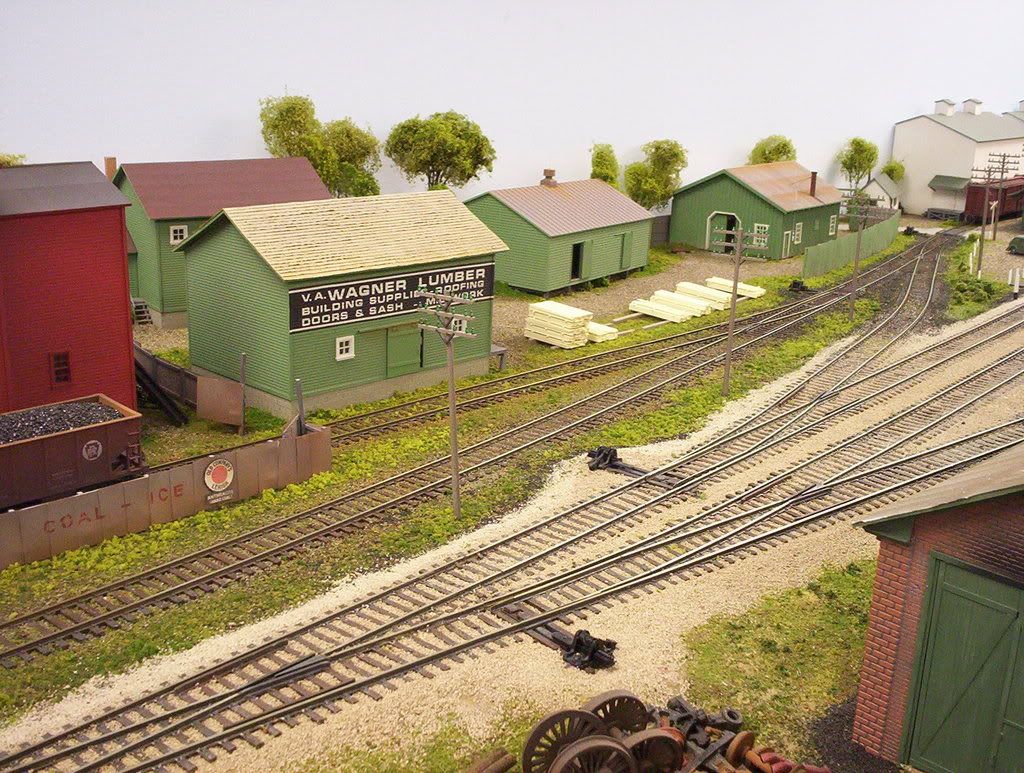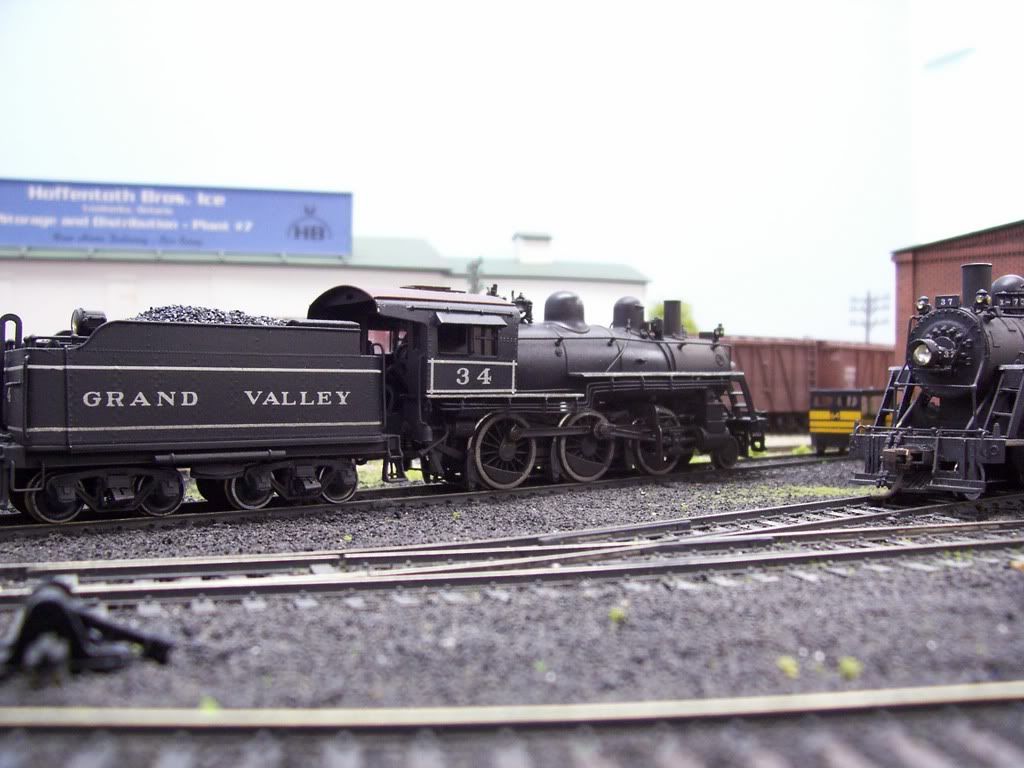Reading through a great bunch of new and old MR mags., I wondered just how prototypical a lot of layouts were, not once did I see a switch stand beside any switches on any layout. Is there some cardinal rule that they cannot be used, next time you look at a freight yard, just count the switch stands, thats what makes a freight yard. Why no switch stands?
I think many are considering the switchstands as “on the backburner”, I for myself is now converting the ones I bought (Details West) to be showing the alignment of the switch.
It is a lot of work to make them and as such I think that is the biggest reason why so many wait to install them. They are very sensitive as well, so no glue near them when installed!!
I think its one of those details that takes a back seat to keeping things running and completing other sections first. At least it is for me.
I have several of the Caboose Industries switch stands. They’re cheap, and they work. I use them in the yard, along the lead, where I can reach them.
I’m currently working on the bechwork for a portable HOn3 switching layout and will be using the brass harp stands from Precision Scale to throw my stub turnouts.
I’ll be using a combination of brass and plastic harp stands on my shelf layout in my home office. The plastic stands will be used as routing indicators for the turnouts that are to be thrown by the Hump Yard controls while the brass stands will be used where the turnouts are within easy reach.
Vernon
Edited for spelling
Gee, I have switchstands on all but one of my turnouts, and have had no compliments for including them, although I have had several comments on how they ruin otherwise decent pictures. [swg]




For the part of the layout yet to be built, I’m going to try building remotely operated manual switches, with working scale-size switchstands. I had them on my first layout.
Wayne
I use switch stands in my yard area. As a matter of fact i went one step further and installed a bi-color SMD LED on a cross tie just behind my Tomar switch stands. Although not very prototypical the faint glow from behind the stand gives me the position of the T/O at a glance. Also something real cool about seeing seven red or green switch stands all in a row with the overhead lights out… I bought a 8 1/2 in alum reflector and a 60 watt blue bulb today to simulate moon glow. My goal from the beginning has been to have enough incidental lighting on the layout from bldg, yard lights, locos etc along with a blue moon bulb to be able to operate with the lights off. These lit switch stands will help make that possible. And yes they were a PITA to wire but well worth it.

It’s one of those details thats often over looked or ignored in some cases. I once spent about 2-1/2 hours getting an operating switch stand to function correctly. I now have it down pat I am happy to say but I guess maybe the purest will want to throw rocks at me for saying this but I know it’s not prototypical to use dwarf signals in my yard but fudge it I just like the way they look.and being the sole proprietor and CEO of this railroad thats what I want. I envy those who can get every little detail just so as it was on the prototype but that kinda stuff is way down on my list of priorities right now. Little things like that I can always go back to some day down the road if I so choose but most likely won’t. Reason being is if I had to go back and correct every little thing thats wrong with my railroad I would wind up tearing the whole thing apart…lol I am happy if the choo choo’s don’t fall off the track right now.
I like those details.

You can see my How To at my site or read this article.
And they work !
Wolfgang
Hand-operated switch stands in the smaller scales are so gross. They totally destroy the scene’s realism. Better to have “underground” switch machines (electrical or manual) and use properly scaled switchstands either dummy or moving.
Allegheny, I am with you on this one. I, too, use dwarf signals in my yard. In the photo which follows, I use Tomar Industries throughout my freight yards.
Rich

I use Caboose Industries Hi-Level Switch Stands throughout my passenger station annex. I love 'em, but I will say this. The asembly of these switch stands is tedious and time consuming. I wound up painting the lights bright green and bright red so they stand out from a distance to faciltate switching in the right direction. If anyone wants some advice in how to assemble these little guys, drop me an email. Here is a photo, albeit a poor one.

I’m slowly adding switch stands to finished areas on the layout. I use Osborn Model Kits switch stands.
I thought my switches looked a little naked, so I added operating switch stands, per Wolfgang’s excellent tutorial. DJ.
!(http://i297.photobucket.com/albums/mm237/GrampysTrains/Quiet time in yard/P1040077.jpg)
Sorry guys, I meant manual, hand operated switch stands( if that’s the proper terminology) they can be operational OR non-functional or just above electric hidden swithches simply for effect , wouldn’t it look better if they were represented even being non-functional? I think it would add realism to a yard or any switch.
now for us lacking ,what do they tell the train crew ,is it no sign is straite and sign we turn ?Im only guessing but I would like to know? …ps great shot of the yard ,really nice…Jerry
… and the color tells where you’re. Red target for turnouts off the main, yellow targets at spurs.
And I guess there’re exceptions.
Wolfgang
If in doubt, follow your prototype.
Following my prototype, I will have one station with five sets of points (two sets = double slip switch) without switch stands. What they WILL have is bellcrank-connected rods to the interlocking levers on the station platform. All movement through them will be controlled by lower-quadrant semaphores or cable-pull dwarfs controlled from other levers attached to that interlocking machine.
Other places will have electric motors, and adjacent dwarf signals (or more distant full-height signals.)
And then there are the two stations where the spring switches will have tall switchstands, topped with blue disk with white S targets - just like the prototype. Unlike the prototype, they won’t move when the points get ‘sprung.’
Last, but not least, there will be those turnouts with (non-operating) manual switch levers. Those are low-height levers, not switch stands - they have no way of indicating point position.
On my present trackage, all of which is in the netherworld and not meant to see the light of day, I don’t bother.
Chuck (Modeling Central Japan in September, 1964 - to prototype switch control design)
Showing the edge of the target means that the switch is thrown for straight; showing the face of the target means the switch is thrown for the diverging route. See: http://railroadsandtrains.com/?p=76
I have always felt that some details intended for a given scale are much too large, and having built only the one Caboose Hobbies ground throw, I am not going to continue with them…about three times the size they should be. I am going to construct some Details West track stands in the future, and I hope they will look as good as Wolfgang’s and Grampy’s. I may even try to make one functional…
-Crandell
